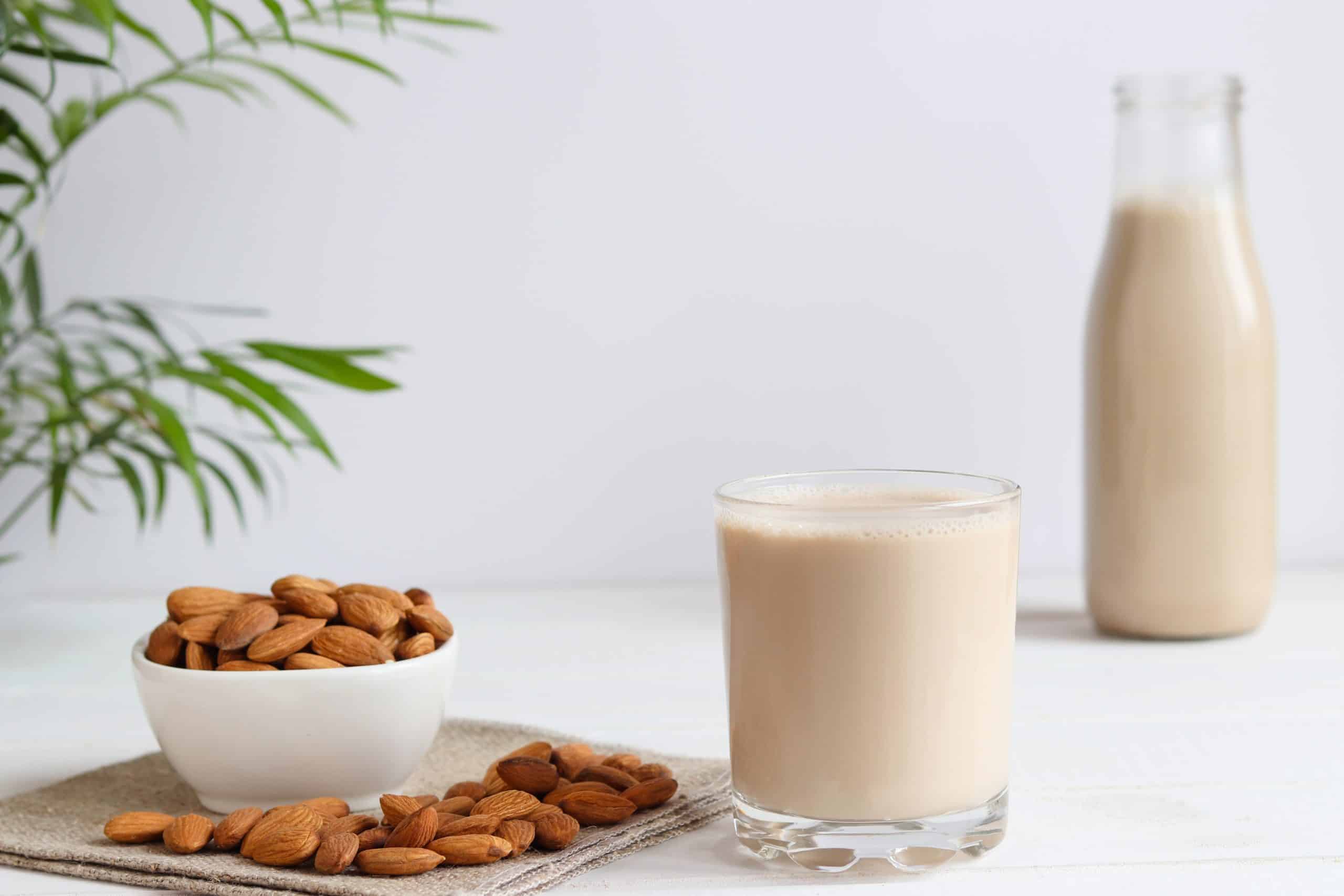Is almond milk better than cow’s milk for weight loss? What about the other benefits? Determining which milk works better for your lifestyle and health goals will give you the information you need to make the best choice. You’ve likely heard good things about both but don’t know which is better.
The answer to “Is almond milk better than cow’s milk for weight loss” depends more on the factors in your diet and lifestyle than anything else. Also, one might be better for certain people while the other is a better fit for a different lifestyle or dietary requirement, yet both can be healthy choices. Let’s help you discover the answers you’re looking for.
Is Almond Milk Better Than Cow Milk for Weight Loss?
Almond milk may be helpful for weight loss for the following reasons (2, 25):
- Almond milk is low-calorie (especially when unsweetened)
- It has only a few carbs (when unsweetened)
- It’s low-fat
- It’s calcium-rich (when fortified)
However, let’s determine which milk is the best for weight loss and other health benefits.
Which Milk Is the Healthiest?
Is almond milk healthier than regular milk? Being healthier doesn’t always mean something promotes weight loss. There are other considerations, like the important nutrients it provides, and how it fits into one’s lifestyle or dietary requirements. Let’s uncover all the facts, nutrition, and recommendations for both kinds of milk before determining which is the healthiest and which is better for weight loss.
Almond Milk vs. Cow’s Milk Nutrition
First, discover the nutrition facts in different kinds of almond and cow’s milk to distinguish the health benefits based on the nutritional information for one cup (2, 25, 12, 1, 19).
| Nutrition Values | Sweetened Almond Milk | Unsweetened Almond Milk | Fat-Free Cow’s Milk | Low-Fat (2%) Cow’s Milk | Whole Cow’s Milk |
|---|---|---|---|---|---|
| Calories | 73.2 | 28.8 | 91.2 | 120 | 149 |
| Carbs | 12.8 g | 1.01 g | 13 g | 12 g | 11.7 g |
| Fat | 2.27 g | 2.5 g | 0 g | 4.99 g | 7.93 g |
| SFA | 0.18 g | N/A | N/A | N/A | 4.54 g |
| MUFA | 1.38 g | N/A | N/A | N/A | 1.98 g |
| PUFA | 0.56 g | N/A | N/A | N/A | 0.47 g |
| Protein | 0.92 g | 1.01 g | 7.99 g | 7.99 g | 7.69 g |
Please note that the values for the following shared in the table mean(2, 25, 12, 1, 19):
- SFA – saturated fat
- MUFA – monounsaturated fat
- PUFA – polyunsaturated fat
Here are some minerals and vitamins in the different kinds of milk (2, 25, 12, 1, 19):
| Nutrition Values | Sweetened Almond Milk | Unsweetened Almond Milk | Fat-Free Cow’s Milk | Low-Fat (2%) Cow’s Milk | Whole Cow’s Milk |
|---|---|---|---|---|---|
| Calcium | 432 mg | 451 mg | 300 mg | 300 mg | 276 mg |
| Magnesium | 14.6 mg | N/A | N/A | N/A | 24.4 mg |
| Phosphorus | 22 mg | N/A | N/A | N/A | 205 mg |
| Potassium | 156 mg | 161 mg | 410 mg | 389 mg | 322 mg |
| Vitamin C | O mg | N/A | 2.4 mg | 2.4 mg | 0 mg |
| Vitamin D | 100 IU | 199 IU | 101 IU | 101 IU | 124 IU |
Cow’s milk typically also contains vitamins B-6, B-12, and E, as well as niacin, riboflavin, choline, and carotenoids. Most cow’s milks and milk alternatives like almond milk are fortified with added vitamin A and vitamin D. Many kinds of non-dairy milk also are fortified with calcium and other nutrients to make them comparable to cow’s milk, or to provide a source of nutrients which are harder to get from plant-based foods. (2, 25, 12, 1, 19).
BetterMe App helps you achieve your body goals with ease and efficiency by helping to choose proper meal plans and effective workouts. Start using our app and you will see good results in a short time.
Which Milk Is the Best for Weight Loss?
The Mayo Clinic recommends cutting at least 500 calories a day to lose ½-1 pounds weekly (7). They also suggest cutting high-calorie items like whole milk for skim milk, letting you slice 58 calories per serving. Still, you could reduce calories more by using almond milk.
Whole milk has 149 calories per cup while fat-free milk still has 91.2 calories per cup (19, 12). Instead, a cup of unsweetened almond milk only has 28.8 calories to reduce each cup’s calories by at least 62.4 (25). However, almond milk is much lower in protein. Protein is important for weight loss because it helps maintain muscle mass and can make you feel full longer and potentially eat less overall.
The UK Center for Obesity Research review found that low-calorie diets described as a 600 calorie deficit daily had better weight loss results than aiming for a set 1200 calories daily (14). However, balancing carbs, protein, and fat macronutrients helped dieticians further assist individuals with weight loss.
Meanwhile, a University of Connecticut review found that exercise is the final key to support low-calorie and well-balanced diets for weight loss (9). Here are some ideas, courtesy of Harvard U. to burn around 400-600 calories in 60 minutes if you weigh 155 pounds (6):
- Low-impact aerobics
- Moderate-intensity rowing
- Ballroom dancing
- Hiking
- Swimming
- Playing tennis or soccer
- Cycling at 12-13.9 mph
Also, do these activities for 30 minutes to burn 300-450 calories if you weigh 155 pounds (6):
- Mountain cycling
- Running cross-country
- Martial arts
- Fast jump rope
- Swimming vigorous laps
- Running at 7.5 mph
- Cycling at 16-19 mph
- Vigorous calisthenics
When Should I Drink Almond Milk for Weight Loss?
Almond milk doesn’t only cut calories. Instead, you’ll enjoy only 1.01 g of carbs per cup of unsweetened almond milk (25). The Mayo Clinic says a typical low-carb diet restricts carbs to 20-57 grams total daily, which is popularly used for weight loss (15).
Interestingly, the Harvard T.H. Chan School of Public Health reviewed data from over 100,000 study participants to compare different types of low-carb diets (16). The results found that the quality of a low-carb diet better indicated long-term weight maintenance.
Individuals who ate less refined carbohydrates, more plant protein, and healthy fat gained less weight over 4 years. Almond milk has the least saturated fat, whereas whole milk has the most (2, 19). Shifting to unsaturated fat sources in almond milk may aid long-term weight loss.
Eating a balanced diet with complex carbs, good fats, and lean protein is necessary for weight loss and maintenance. You can cut your calories and carbs with almond milk for weight loss, but look for additional sources of plant-based protein, perhaps by choosing an almond milk fortified with pea protein, for example.
Read more: Raw Milk Benefits: Will the Advantages Outweigh the Potential Risks?
Almond Milk vs. Cow Milk Protein
Is almond milk healthy when compared to the protein content of cow’s milk? Unfortunately, almond milk has only 0.92-1.01 grams of protein per cup (2, 25). A cup of cow’s milk has 7.69-7.99 grams of protein (12, 1, 19).
Also, the milk protein in cow’s milk has all nine essential amino acids, with 20% of the protein originating from whey protein, which is more heat resistant in processing (11). The remaining 80% of the protein is primarily casein.
Ultimately, cow’s milk offers you a high-quality, complete protein source. An Iranian review suggested that complete milk proteins found in cow’s milk may be associated with a stronger immune system and lower blood pressure, among other potential health benefits (11).
Also, a Portuguese randomized trial found that whey protein supplementation, along with resistance training increased muscle thickness and mass (13). Meanwhile, a Konkuk University review found that consuming casein protein 30 minutes before bed (and after an evening exercise session) may help post-exercise muscle recovery (21).
Milk proteins seem to be good for bulking or muscle strengthening. Complement weight loss with resistance training and cow’s milk if that’s the goal, also helping new trainers recover better from muscle exhaustion after workouts.
Does Almond Milk Have More Calcium Than Regular Milk?
Some kinds of fortified almond milk have more calcium per cup than fat-free, low-fat, and whole cow’s milk (2, 25, 12, 1, 19). In the example we found, you get 156-175 milligrams of calcium extra per cup in almond milk. The National Institutes of Health recommends 1,000 milligrams daily for adults (5).
However, women over 50 and all adults over 70 need 1,200 milligrams daily. Also, kids aged 9-18 need 1,300 milligrams daily. Calcium recommendations rise in children and older individuals because of the need for bone health.
Did you know that 99 million adults over 50 have low bone density in the US (20)? The loss of bone density is common among older individuals. Meanwhile, calcium strengthens and hardens your bones, and vitamin D helps your body to absorb calcium (4).
Additionally, children need more calcium and vitamin D because they’re developing bone mass and density throughout adolescence (3). Fortified almond milk may be equally or more calcium-rich, compared to cow’s milk and is often fortified with vitamin D. Still, cow’s milk is also an excellent source of calcium and vitamin D.
Benefits of Almond Milk for Females
Almond milk may provide additional benefits for women entering menopause. Menopausal women lose more bone density than men, putting them at greater risk for osteoporosis (20). Hormone changes can interfere with calcium absorption and secretion.
Almond milk is often fortified with calcium and vitamin D to help menopausal ladies (2, 25). Also, almond milk has a good amount of magnesium (2). Magnesium may also promote bone integrity (17). However, cow’s milk is also an excellent source of all these bone-health nutrients, so choose whichever milk you prefer or meets your dietary requirements.
Other Almond Milk Benefits
Cow’s milk is the complete protein that offers various benefits (11). Still, almond milk has some advantages over cow’s milk if you don’t need the complete protein or follow a plant-based diet. For example, fortified almond milk can have as much as 50% of your recommended daily vitamin E per cup (25).
An Indian review found that vitamin E could reduce risks and complications associated with heart disease, cancer, cataracts, and Alzheimer’s Disease (24). Vitamin E also supports your immune system. Also, almond milk may be okay for people with kidney disorders.
The Cleveland Clinic says people with kidney problems must manage potassium and phosphorus intake (22). Sweetened and unsweetened almond milk has less than half the potassium of cow milk and only about 10% of the phosphorus (2, 25, 12, 1, 19). It is also much lower in protein, which some people with chronic kidney disease need to limit.
Additionally, almond milk provides an alternative for lactose intolerant individuals. Almond milk has no lactose, a natural sugar found in dairy products (10). It’s a suitable plant-based milk for lactose intolerant individuals or vegans who avoid animal products.
If you wish to free yourself from all the extra pounds that have been weighting you down for way too long, start using the BetterMe app and overhaul your entire life!
Is Almond Milk Better Than Cow’s Milk for the Environment?
Our World in Data shows that almond milk production uses less land, water, causes less eutrophication and has fewer greenhouse gas emissions than cow’s milk production by BigAG (8). Eutrophication occurs when nutrients build in a body of water, often depleting the water’s oxygen.
Almond milk betters cow’s milk in all the data, albeit more freshwater is needed for almond trees than other plant-based milks. Ultimately, almond milk production has a lower environmental impact than cow’s milk.
Almond Milk vs. Oat Milk Nutrition
Unsweetened almond milk has 28.8 calories, 1.01 g of carbs, 2.5 g of fat, and 1.01 g of protein per cup (25). On the other hand, a cup of one brand of oat milk has 120 calories, 16 g of carbs, 4.99 g of fat, and 3 g of protein (23). Plant-based milk can vary widely in their nutritional content, depending on nutrient fortification and other additives. It’s best to compare nutrition labels of specific products when choosing one that meets your needs.
For more healthy reading:
FAQs
Which Milk Is the Best for Losing Belly Fat?
Losing belly fat requires eating fewer calories overall. Of the cow’s milk varieties, fat-free milk contains the fewest calories. A large study at Brigham Young University compared body mass index (BMI) and stomach adiposity among over 13,000 individuals with milk fat intake (18). Results showed that the lowest milk fat intakes were associated with a smaller waist circumference. Fat-free milk has no fat (12).
Which Milk Gives More Fat?
Whole cow’s milk with 3.25% milk fat has the highest fat content with 7.93 g of fat per cup (19). In addition, whole milk provides complete protein and is suitable for bulking, muscle strengthening, and gaining a few pounds (11). Almond milk only has 2.27 g of fat per cup and is very low in protein (2).
Can I Drink Milk if I’m Losing Weight?
You can drink low-calorie milk when trying to lose weight because you should be cutting at least 500 calories a day to lose ½-1 pound weekly (7). The lowest calorie choice from our picks is unsweetened almond milk with only 28.8 calories per cup (25).
Can Avoiding Milk Reduce Weight?
Regular cow’s milk has 149 calories per cup (19, 7). Drinking multiple cups of milk in a day can add up to a lot of calories. However, unsweetened and enriched almond milk may be a lower-calorie alternative for people who love milk because it has fewer than 30 calories per cup (25).
The Bottom Line
Is almond milk better than cow’s milk for weight loss? Maybe – it is lower in calories. Is almond milk better than cow’s milk for muscle gains? Maybe not, cow’s milk is richer in high-quality protein. Also, do you tolerate lactose, or do you prefer to avoid animal products? Consider your goals and dietary requirements before determining whether you need almond or cow’s milk for your healthy lifestyle. Also, either cow’s milk or fortified almond milk will support strong bones and other benefits.
DISCLAIMER:
This article is intended for general informational purposes only and does not serve to address individual circumstances. It is not a substitute for professional advice or help and should not be relied on for making any kind of decision-making. Any action taken as a direct or indirect result of the information in this article is entirely at your own risk and is your sole responsibility.
BetterMe, its content staff, and its medical advisors accept no responsibility for inaccuracies, errors, misstatements, inconsistencies, or omissions and specifically disclaim any liability, loss or risk, personal, professional or otherwise, which may be incurred as a consequence, directly or indirectly, of the use and/or application of any content.
You should always seek the advice of your physician or other qualified health provider with any questions you may have regarding a medical condition or your specific situation. Never disregard professional medical advice or delay seeking it because of BetterMe content. If you suspect or think you may have a medical emergency, call your doctor.
SOURCES
- 2% Reduced Fat Milk (2021, fdc.nal.usda.gov)
- Almond Milk, Sweetened (2020, fdc.nal.usda.gov)
- Calcium and Vitamin D Deficiency: What You Need to Know (n.d., childrenscolorado.org)
- Calcium and Vitamin D: Important for Bone Health (2023, niams.nih.gov)
- Calcium – Health Professional Fact Sheet (n.d., ods.od.nih.gov)
- Calories Burned in 30 Minutes of Leisure and Routine Activities (2021, health.harvard.edu)
- Counting Calories: Get Back to Weight Loss Basics – Mayo Clinic (2023, mayoclinic.org)
- Dairy vs. Plant-Based Milk: What Are the Environmental Impacts? (2022, ourworldindata.org)
- Diet and Exercise for Weight Loss: A Review of Current Issues (2005, pubmed.ncbi.nlm.nih.gov)
- Health Benefits of Almond Milk (2022, webmd.com)
- Health-Related Aspects of Milk Proteins (2016, ncbi.nlm.nih.gov)
- [Historical Record]: Fat-Free Milk (2019, fdc.nal.usda.gov)
- Intake of Whey Isolate Supplement and Muscle Mass Gains in Young Healthy Adults When Combined With Resistance Training: A Blinded Randomized Clinical Trial (Pilot Study) (2020, pubmed.ncbi.nlm.nih.gov)
- Low-Calorie Diets and Sustained Weight Loss (2001, pubmed.ncbi.nlm.nih.gov)
- Low-Carb Diet: Can it Help You Lose Weight – Mayo Clinic (2022, mayoclinic.org)
- Low-Carbohydrate Diet Macronutrient Quality and Weight Change (2023, ncbi.nlm.nih.gov)
- Magnesium and Osteoporosis: Current State of Knowledge and Future Research Directions (2013, ncbi.nlm.nih.gov)
- Milk-Fat Intake and Differences in Abdominal Adiposity and BMI: Evidence Based on 13,544 Randomly-Selected Adults (2021, ncbi.nlm.nih.gov)
- Milk, Whole, 3.25% Milkfat, With Added Vitamin D (2019, fdc.nal.usda.gov)
- Muscle and Bone Mass Loss in the Elderly Population: Advances in Diagnosis and Treatment (2018, ncbi.nlm.nih.gov)
- Pre-Sleep Casein Protein Ingestion: New Paradigm in Post-Exercise Recovery Nutrition (2020, ncbi.nlm.nih.gov)
- Renal Diet Basics: Foods, Kidney Health, Risks, Benefits (2021, my.clevelandclinc.org)
- The Original Oat-Milk (2019, fdc.nal.usda.gov)
- The Role of Vitamin E in Human Health and Some Diseases (2014, ncbi.nlm.nih.gov)
- Unsweetened Almond Milk (2023, fdc.nal.usda.gov)









